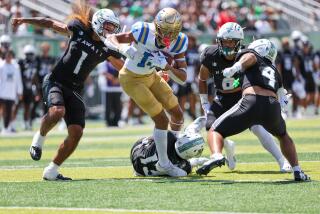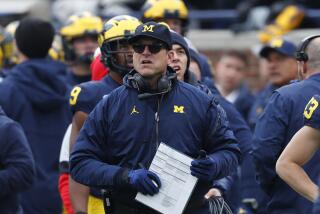Analysis:: Credibility at stake for university-run media in Josh Shaw situation

USC says it regrets posting a report online about cornerback Josh Shaw that said he sprained both ankles while rescuing his 7-year-old nephew from a swimming pool after the senior admitted making up the entire story.
The dramatic -- and now debunked -- tale of Josh Shaw rescuing his 7-year-old nephew from drowning didnât originate with a newspaper or television station covering USC.
Instead, six paragraphs published at 3:29 p.m. Monday on the athletic departmentâs website transformed the senior defensive back into the subject of national adulation in a matter of minutes.
This wasnât a news release or transcript of Coach Steve Sarkisian speaking to assembled media. This was a news story, complete with byline and reader comments, by the Athletic Departmentâs director of social media, continuing a years-long trend of major university athletic departments reporting on themselves in manner that a casual observer may find difficult to differentiate from a regular media outlet.
Some departments have hired former beat writers to write news stories, features and analysis, venturing far beyond the traditional game notes and news releases, as their content-producing operations attempt to rival the traditional media outlets covering them.
âIf youâre in the business of telling stories, you need to make sure your stories are accurate,â said Welch Suggs, an associate professor of journalism at the University of Georgia, who has examined the trend. âOn a team website, you know theyâre going to present the story in the best possible light. But you also have a responsibility not to lie to your audience.â
Other media outlets, including The Times, quickly picked up USCâs story on Shaw, as the original piece rolled up tens of thousands of mentions on social media.
Less than 24 hours later, Sarkisian said the university received conflicting accounts about what actually occurred. On Wednesday afternoon, Shaw admitted he lied about the incident.
âThereâs obviously a self-serving interest to any story that comes out of a university athletic department,â said Daniel Durbin, director of the USC Annenberg Institute of Sports, Media and Society. âThey want to protect the athlete. They want to protect the university. They want to protect the bottom line.â
Suggs sees the imbroglio as raising questions of trust for all involved -- and highlighting the gray areas encountered by university-run media as they provide an outlet for universities to release stories on their terms to amiable reporters.
âPeople donât look at bylines ⌠they trust brands,â Suggs said. âFor journalists, after you have a story like this, it affects your own credibility and the credibility of your organization. But for the general public, theyâre probably not going to make a distinction between whether USCâs public relations staff got hoodwinked in the same way that other media outlets got hoodwinked.â
Such athletic department content producers are brought on as part of efforts to create a positive narrative and help to build a brand, Durbin believes. These goals are often in conflict with a mainstream journalistâs call to be objective and truthful.
âIf thereâs anything less than scrupulously honest in the story thatâs created or helped to be created ⌠itâs going to be found out,â Durbin said. âYou have to be very careful they donât set you up for trouble.â
Follow me on Twitter.
More to Read
Go beyond the scoreboard
Get the latest on L.A.'s teams in the daily Sports Report newsletter.
You may occasionally receive promotional content from the Los Angeles Times.







